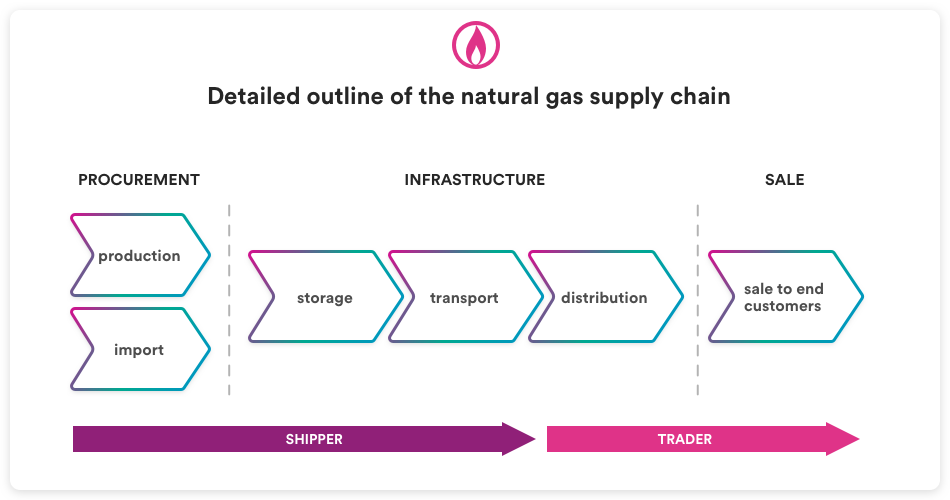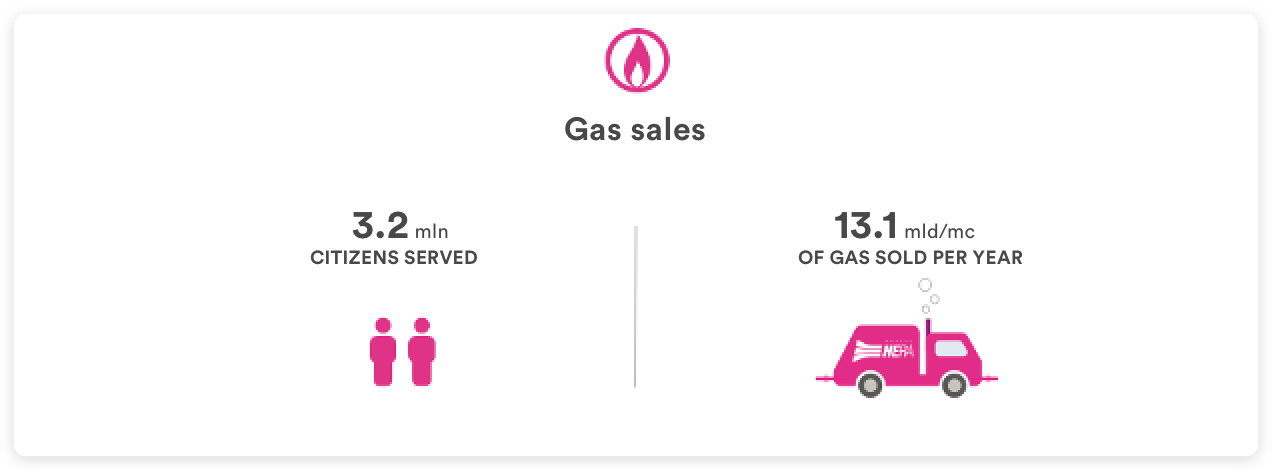Gas
Detailed outline of the natural gas supply chain
The gas supply chain in its entire production cycle begins with the procurement phase and moves through the infrastructure to end, after distribution, with the final link of sale. In brief, this is the entire series of activities that take place between the moment in which the gas is withdrawn, perhaps in a far-off Russian deposit, and the moment in which we turn on our home stove or our gas boiler for heat.

Production or import
The first phase in the supply chain consists of the production and import of methane gas, commonly defined as the procurement process, through which the quantities necessary to meet domestic requirements are obtained. Domestic production accounts for a minimal percentage of our country's consumption as Italian deposits have been almost completely depleted. The remainder is imported by pipeline and to a lesser extent by ship (liquefied natural gas, or LNG). The natural gas injected into the national transport network comes from imports and, to a lesser extent, from domestic production. Imports via pipeline take place through the international gas pipelines that connect Italy with major foreign producers. Procurement via ship takes place for the import of liquefied natural gas. In this case, the gas extracted in the production locations is cooled until reaching a liquid state, so it can then be loaded on LNG carriers, which travel to our border. After reaching its destination, the LNG is heated for the purpose of regasification and subsequently injected into our national gas pipeline network.
Storage
Withdrawals of natural gas are never constant over time, as they are susceptible to changes primarily due to the different uses made of natural gas. The most significant changes derive from the use of natural gas for heating, which can cause consumption peaks in the winter months and declines in the summer months. Therefore, demand is highly variable based on season and day, primarily as a result of the residential sector, in which the use of gas for heating is prevalent.
However, on average the volume of natural gas required to meet our needs is injected into the national network continuously and constantly, as if usage remained constant over time. This would cause us to have an excess of gas in the summer and a shortage in the winter. To deal with this issue, we use a storage system: a system of "tanks" in which we can store excess gas for use during times of high demand - in other words, a system capable of modulating gas consumption with respect to the average value.
Wholesale trade of natural gas
Shippers are those parties within the supply chain that produce or import gas, or purchase it from domestic producers or other shippers, to then sell it to direct end customers (industry and thermoelectric power plants) and/or to other retail companies that sell to indirect end customers.
To carry out their activities, shippers use national and regional transport networks and the storage network in order to transport gas from the national network entry points and modulate it at the delivery points.
Therefore, the activity of shippers is linked to the procurement and wholesale trade of natural gas.
The national transport service provided by Snam and by S.G.I. to shippers is governed by a transport agreement and subject to a tariff defined by the Authority (ARERA).
The national storage service was deregulated in 2013 and is provided by various operators in Italy. The service is governed by a storage agreement and is subject to a tariff defined by the Authority.
Transport
The natural gas procured needs to be conveyed to the points at which it is used.
At national infrastructure level, natural gas is transported under high pressure through large-diameter underground pipelines separated into two gas pipeline networks: the national transport network and the regional transport network. The first originates at the national entry points (gas withdrawn from production or import locations) and flows through the national network to the regional transport network. The regional transport network encompasses the set of pipelines (secondary lines), which link the national network and consumption centres (delivery points).
Snam Rete Gas S.p.A. controls 96% of the overall network; Società Gasdotti Italia S.p.A. manages roughly 1,300 Km of methane pipelines and holds control over the remaining 4% of the overall network.
In the transport process, natural gas is sent to the delivery points. At these points, the gas may be entrusted to local distribution companies (which in turn will convey the natural gas to end customers after first filtering, pre-heating, decompressing, measuring flow rate and volumes and odourising it) or directly to one or more end customers. This last case refers to direct end customers, i.e., customers served directly by the national network - these are typically very large users with high consumption and dedicated delivery points.
Natural gas is transported through the national network under high pressure, while downstream from the delivery points, the gas may be transported under medium or low pressure. At the delivery points, pressure is regulated in regulation and measurement stations. Transport operators are also responsible for the settlement of transported gas.
Distribution
Distribution activities include the delivery of natural gas to end customers through networks of functionally integrated local gas pipelines. Technically, the distribution structure consists of the set of delivery points (regulation and measurement stations) and/or connection points, the network itself, reduction units and/or final reduction units and the utility distribution plants to the end customer supply points (referred to as redelivery points).
As end customers are not directly connected to the transport network in this case, they are referred to as indirect customers.
Distribution is a public service activity, subject to the granting of a concession during a public procurement procedure, and relations between the commissioning authority and the operator are governed by a service agreement.
Aside from the maintenance, management, development and integration of methane pipelines/plants, the main activity of distributors consists of conveying gas to end users through the distribution service.
Since 1 July 2009, distribution companies have also been responsible for surveying and validating metering data present in meters (metering units) as well as distribution settlement, i.e., all activities and reports required under the regulation for the distributor to distribution users (sales companies) to determine physical and financial data (energy reporting) for the natural gas balancing service and the subsequent adjustment sessions. The latter make it possible to settle the accounts deriving from differences between the withdrawal data determined during the balancing phase and those determined on the basis of actual measurements received subsequently.
For metering, the regulation was issued to govern the adaptation of gas metering units to equip them with remote reading and remote management functions at redelivery points in the natural gas distribution networks, establishing a gradual and compulsory timetable by class of metering unit and type of distribution company.
Sale to end customers
Traders are parties that sell to end customers, which directly or indirectly provide natural gas to distribution service users and which in turn obtain natural gas by virtue of contracts entered into with transport network users (i.e., shippers).
To carry out their activities, traders use local distribution networks to withdraw natural gas from delivery points and deliver it to redelivery points (or end customer supply points).
Therefore, the activities of traders are linked to retail natural gas sales. The distribution service is governed by contracts entered into by the distributor and the vendor (referred to as “distribution contracts”) and is subject to a tariff defined by the Authority (ARERA).
The Group’s strategy is based on covering the end consumption market already acquired. To achieve this goal, it works based on a careful diversification of procurement sources, with direct access to foreign supplies through direct agreements with international producers and participation in specific infrastructural initiatives to provide its customers with a high degree of supply security.
As regards the downstream segment, the Group is highly committed to optimising the activities and structures involved in natural gas distribution so as to focus more directly on the development requirements of the area served.
In addition, its dedication to technological innovation is seen particularly in the area of gas procurement, where the HERA Group is one of the top Italian companies committed to the construction and management of plants for the direct production of biomethane from biomass, thereby transversally integrating the Group's various business areas.

Hera Comm, a commercial company of the Hera Group, is the third national operator in the sale of gas and electricity in terms of number of customers and it operates throughout Italy.
Hera Comm is also the leading operator in the Gas Protection Service in Liguria, Piemonte, Valle D'Aosta, Trentino Alto Adige, Veneto, Lombardia, Friuli Venezia Giulia, Emilia Romagna, Toscana, Umbria e Marche. Opera come fornitore del servizio di default nel gas in Liguria, Piemonte, Valle D'Aosta, Friuli Venezia Giulia, Emilia Romagna, Toscana, Umbria, Marche, Abruzzo, Molise, Basilicata, Puglia, Lazio, Campania, Sicilia e Calabria..
The company, with its headquarters in Imola (BO), was established in 2001 and enjoyed continuous and significant growth over the years that followed. A market development made possible by a winning commercial strategy based on product innovation and a multi-business offer capable of responding to the consumption requirements of different market segments, from domestic to industrial, passing through the diverse world of VAT registration numbers. Hera Comm operates through a commercial network structured and differentiated according to the market segments it targets.
It currently supplies natural gas to 3.2 million customers, selling a total of 13.1 billion cubic metres.
Page updated 7 July 2023
Creating shared value report 2024
